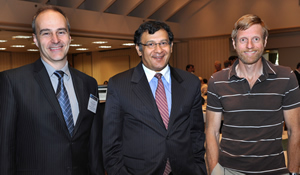Cap & Trade Conference Gauges Legislative Impact
UH GEMI and EENR Host Energy Industry Experts for Cap & Trade Session
Published on July 24, 2009

The carbon trading course taught at UH Bauer puts the college in the forefront of providing the expertise needed to shape the issue at a national level, Kumar said.

Professors Flatt, Kumar and Pirrong shared their insights with a packed ballroom of energy industry executives, attorneys, representatives and others.

The executive session drew comments and questions from the audience.
Energy company executives, attorneys, state agency representatives and others were among those who attended an executive education session presented by the University of Houston Global Energy Management Institute (UH-GEMI) and Center for Environment, Energy and Natural Resources (EENR), “Cutting through Cap and Trade,” July 20 at the UH-Hilton Hotel.
The conference was led by Professor Praveen Kumar, Director of UH-GEMI and Chair of the Department of Finance, Professor Craig Pirrong, Director of Energy Markets for GEMI, and Victor Flatt, GEMI Distinguished Fellow and former UH Professor and Director of EENR (Flatt is currently Distinguished Professor in Environmental Law at the University of North Carolina-Chapel Hill Law School).
The three spoke about the intersection of climate change, environmental law, and emissions and commodity trading, analyzing the potential implications of the American Clean Energy and Security Act (ACES). ACES, the first climate change bill to reach Congress, has been passed by the U.S. House of Representatives and awaits Senate passage.
The session followed on the heels of what is thought to be the country’s first comprehensive carbon trading course, offered at C. T. Bauer College of Business at UH in 2008. Kumar, Pirrong and Flatt also shared findings with congressional research staff and public policy research institutes in the past year.
Some of the topics covered included a review of the trading related provisions of ACES, its implications for pricing of allowances and offsets, price volatility in a man-made market, the definition and certification of carbon offsets and the interface between U.S. and existing European carbon trading systems.
Each speaker stressed that much uncertainty remains about the specifics of any emerging federal framework as the bill moves forward. However, Kumar noted that there is sufficient information on the details of the emerging cap and trade system in the US to begin developing a framework for understanding the pricing implications for allowances and offsets. “Businesses that are regulated and traders will have to understand the interaction among emission reduction costs, allowances, and availability of offsets to effectively deal with the carbon market,” Kumar said. He also noted that unique features like the scope for regulatory revision are likely to lead to considerable volatility, and predicted supply constraints for allowances in the short-to medium run.
“We really don’t know how this is going to work,” Pirrong said. “There is tremendous uncertainty, and the devil is in the details. One major source of uncertainty about offsets is the availability and cost. And one implication of that is that the potential gold rush toward emissions reduction technology might be delayed until this political and regulatory uncertainty is resolved.”
Pirrong noted that unlike other markets subject to seasonal fluctuations and other factors that affect availability, the price of man-made carbon credits will be driven more by political considerations. The resulting uncertainty about price volatility in the face of regime change could have a significant impact on investments, especially those with a long-term return.
Hostility to speculation and over the counter trade is likely to funnel more activity to stock exchanges in Chicago and New York, Pirrong said. “It poses something of a challenge for Houston. But I would expect that trading activity will go through Houston in one way or another, even if the exchanges are involved, creating an opportunity for new market participants.” Growth opportunities for attorneys are also projected, said Flatt. “The definition and certification of offsets is going to depend heavily on environmental lawyers, so the packaging of these is going to create a great demand for environmental attorneys who work in this area.”
Flatt also spoke about the pros and cons of creating separate U.S. carbon trading standards versus adopting existing European guidelines. One benefit of the latter, Flatt said, is that “You would have certifiable offsets that will work not only in the U.S. but in Europe. The question is will they be able to revise it enough to satisfy environmentalists in the U.S.?”
Even in the event that a federal framework for carbon trading doesn’t get Senate approval, companies will need to incorporate carbon trading as individual states begin to require offsets, Flatt said.
That puts UH Bauer in the unique position of providing the expertise needed to make such an evolving system work, Kumar said.
“We definitely have a leading position from teaching that course last spring. In terms of it being important, it’s only going to grow, once it becomes law. Climate change is front and center for the new administration and Congress and they are moving very quickly in this area.”